
Leptospermum scoparium, commonly called mānuka, mānuka myrtle, New Zealand teatree, broom tea-tree, or just tea tree, is a species of flowering plant in the myrtle family Myrtaceae, native to New Zealand and south-east Australia. Its nectar produces Mānuka honey.

Kunzea ericoides, commonly known as kānuka, kanuka, or white tea-tree, is a tree or shrub in the myrtle family, Myrtaceae and is endemic to New Zealand. It has white or pink flowers similar to those of Leptospermum and from its first formal description in 1832 until 1983 was known as Leptospermum ericoides. The flowers have five petals and up to 25 stamens which are mostly longer than the petals.

Kunzea is a genus of plants in the family Myrtaceae and is endemic to Australasia. They are shrubs, sometimes small trees and usually have small, crowded, rather aromatic leaves. The flowers are similar to those of plants in the genus Leptospermum but differ in having stamens that are longer than the petals. Most kunzeas are endemic to Western Australia but a few occur in eastern Australia and a few are found in New Zealand. The taxonomy of the genus is not settled and is complicated by the existence of a number of hybrids.
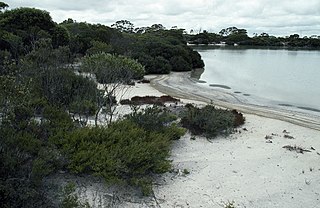
Kunzea salina is a species of flowering plant in the myrtle family, Myrtaceae and is endemic to the south of Western Australia. It is a low, spreading, densely branched shrub with leaves mostly arranged in opposite pairs and usually two sessile pale pink to white flowers arranged at the base of new shoots. It only grows near the edge of certain salt lakes.

Kunzea baxteri, commonly known as scarlet kunzea, is a flowering plant in the myrtle family Myrtaceae, and is endemic to the south-west of Western Australia where it occurs near granite outcrops and hills. It is a shrub with large, scarlet, bottlebrush-like flower clusters, making it popular as a garden feature.

Kunzea jucunda is a flowering plant in the myrtle family, Myrtaceae and is endemic to the south-west of Western Australia where it occurs on sandy or rocky soils of undulating plains. It is similar to Kunzea affinis and where the ranges of the two species overlap, hybrids occur.
Kunzea peduncularis, commonly known as mountain burgan, is a flowering plant in Myrtaceae, the myrtle family, and is endemic to Victoria, Australia. It is usually a dense shrub and has lance-shaped to egg-shaped leaves with the narrower end towards the base. Dense groups of white flowers appear in early summer.
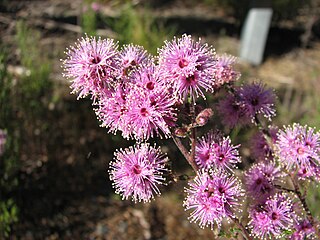
Kunzea parvifolia, commonly known as the violet kunzea, is a flowering plant in the myrtle family, Myrtaceae and is endemic to eastern Australia. It is a wiry shrub with small, narrow leaves and clusters of pink to purple flowers in spring.

Kunzea newbeyi is a flowering plant in the myrtle family, Myrtaceae and is endemic to a small area along the south coast of Western Australia. It is a robust shrub with small leaves and groups of about twenty to thirty pink flowers in October and November.
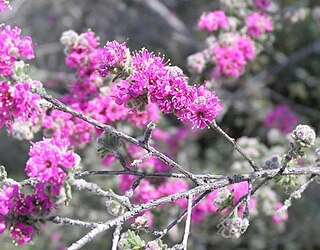
Kunzea preissiana is a flowering plant in the myrtle family, Myrtaceae, and is endemic to the southwest of Western Australia. It is a shrub with hairy branches and leaves, pink to mauve flowers in groups on the ends of shoots, and twenty to thirty stamens about the same length as the petals. It is a widespread, often locally common species across its range.

Kunzea amathicola, also known by the Maori names manuka and rawiritoa, is a flowering plant in the myrtle family, Myrtaceae and is endemic to New Zealand. It is a densely-branched, densely-foliaged large shrub or tree with sprays of large white flowers with a red centre.

Kunzea obovata is a flowering plant in the myrtle family, Myrtaceae and is endemic to eastern Australia. It is a spreading shrub with unusually-shaped leaves and clusters of pink to purple flowers. It is restricted to northern New South Wales and south-eastern Queensland.
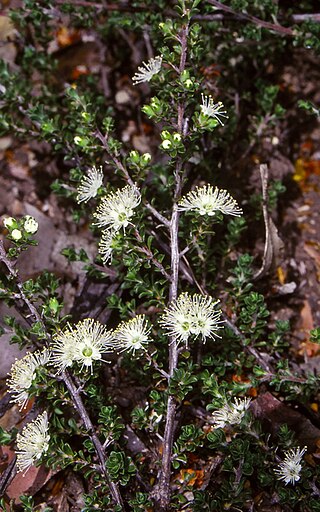
Kunzea badjaensis is a flowering plant in the myrtle family, Myrtaceae and is endemic to a small area of New South Wales. It is a shrub with egg-shaped leaves and clusters of white flowers near the end of the branches. It grows at high altitudes on the Southern Tablelands.
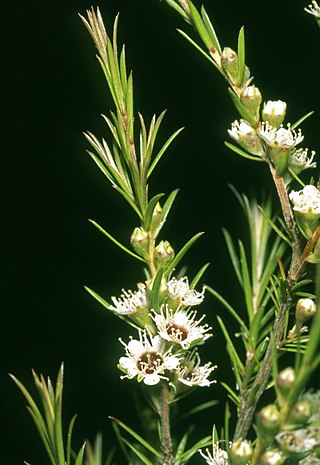
Kunzea linearis, also known by the Maori name rawiri manuka, is a flowering plant in the myrtle family, Myrtaceae and is endemic to New Zealand. It is a densely-foliaged shrub or small tree, characterised by very narrow leaves and clusters of small white flowers with five petals and a large number of stamens, which are longer than the petals. It grows in the north of the North Island and is the most distinctive of the New Zealand kunzeas.

Kunzea leptospermoides, commonly known as Yarra burgan, is a flowering plant in Myrtaceae, the myrtle family, and is endemic to Victoria, Australia. It is an erect shrub or small tree with narrow leaves and white flowers crowded near the ends of the branches in spring.

Kunzea occidentalis is a flowering plant in the myrtle family, Myrtaceae and is endemic to a western New South Wales. It is a shrub with narrow leaves and small groups of white flowers on leafy side-branches. It is distinguished from the similar Kunzea ambigua by the flanges on the sides of its young branches.
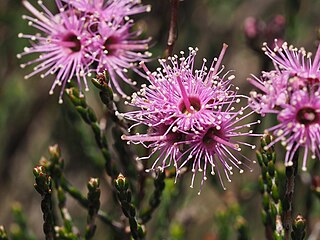
Kunzea opposita is a plant in the myrtle family, Myrtaceae and is endemic to eastern Australia. It is a spindly shrub which has small leaves arranged in opposite pairs, and pink flowers with five petals and many stamens, the stamens much longer than the petals. It usually grows in woodland or on exposed cliffs.

Kunzea serotina, commonly known by its Māori name makahikatoa, is a flowering tree or shrub of the family Myrtaceae in the genus Kunzea, found in both North Island and South Island of New Zealand.

Kunzea phylicoides, commonly known as the slender burgan, is a flowering plant in the myrtle family, Myrtaceae and is endemic to south-eastern Australia. It is an erect shrub with drooping branches, fibrous or corky bark, bright green, narrow leaves and clusters of white flowers in spring.

Kunzea salterae, also known by the Maori name moutohora kanuka, is a flowering plant in the myrtle family, Myrtaceae and is endemic to Moutohora Island in New Zealand. It is a much-branched shrub or small spreading tree with needle-like leaves, sprays of white flowers and small cup-shaped or urn-shaped fruit.


















